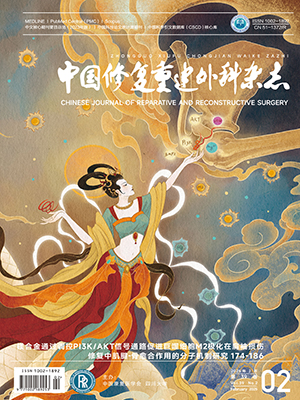Objective The immunogenicity of tissue engineered skins is still vague, though it has been appl ied cl inically for several years. To observe the evidence of immunologic rejection of tissue engineered skins transplanted to severe combined immunodeficiency (SCID) mice, which are implanted human splenic lymphocytes to construct human immune
system. Methods Tissue engineered skins and acellular dermic matrix were constructed in vitro. Twenty SCID mice, aging
4-6 weeks and weighing 16-17 g, were randomly divided into four groups equally (n=5). The tissue engineered skins, human foreskins from circumcision and acellular dermic matrix were transplanted to groups A, B, and C, respectively; group D was used as a control. After 2 weeks of transplanting, 3 × 107 human splenic lymphocytes were injected into every SCID mouse intraperitoneally. After 4 weeks, the morphology, histology, immunohistochemistry and human IgG immunofluorescence were used to observe immunologic rejection. Results Group A showed that transplanted tissue engineered skins had the bilayer structure of dermis and epidermis, which was similar to the normal human skin structure. Group B showed that the transplanted human foreskins still retained normal structure of human skin. Group C showed that acellular dermic matrix were located in situ and had no sign of degradation. After injecting human splenic lymphocytes into the SCID mice, no inflammatory cells infil itration were observed basically in groups A, C, and D; the inflammatory cells infil itration of group B were significantly higher than that of other 3 groups (P lt; 0.05). The results of anti human keratin 14 monoclonal antibody (mAb) staining and anti human type IV collagen mAb staining were positive in group A; no positive cells for CD3, CD4, and CD8 were observed in groups A, C, and D; and many positive cells for CD3, CD4, and CD8 were observed in group B. The results of IgG immunofluorescence staining was negative in group A, C, and D, and positive in the great vessel wells of group B. Conclusion The immunogenicity of tissue engineered skins is very weak, and tissue engineered skins would not be rejected by host immune system after transplantation.
Citation: BI Jianjun,WU Jinjin,ZHANG Caimao,ZHU Tangyou,LU Yuangang. .. IMPLANTING HUMAN SPLENIC LYMPHOCYTES INTO SEVERE COMBINED IMMUNODEFICIENCY MICE TRANSPLANTED WITH TISSUE ENGINEERED SKINS. Chinese Journal of Reparative and Reconstructive Surgery, 2010, 24(3): 350-355. doi: Copy
Copyright © the editorial department of Chinese Journal of Reparative and Reconstructive Surgery of West China Medical Publisher. All rights reserved




